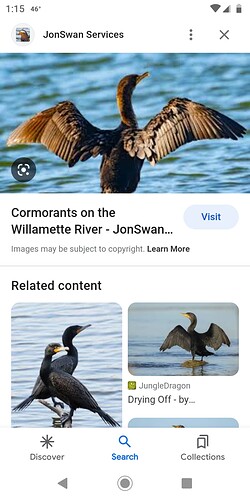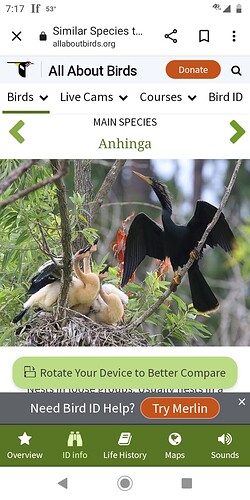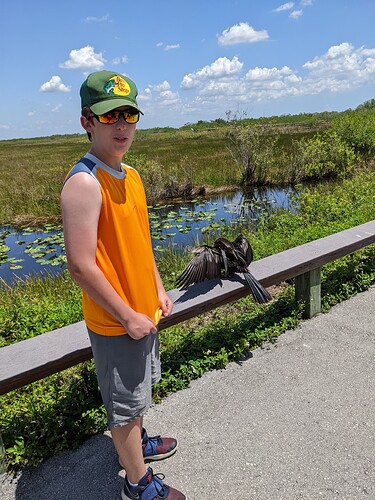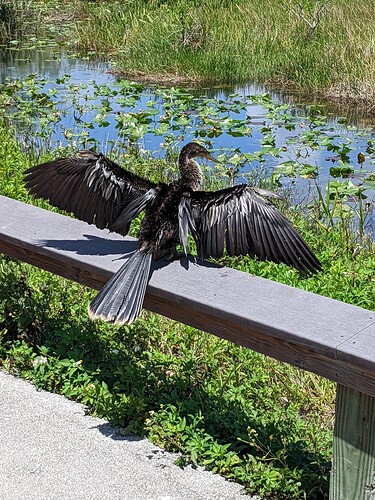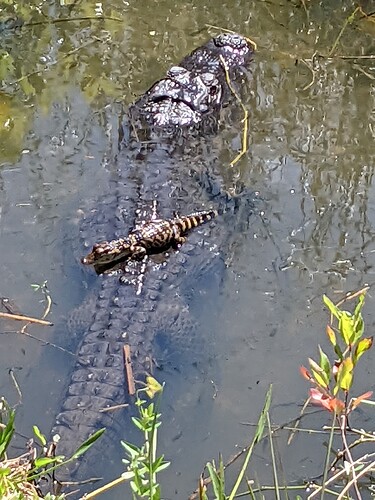Wow! Can I borrow that to go with my cuff?  I promise I’ll give it back…
I promise I’ll give it back…
You have to wear it with a long extender or you’ll get a beak in the jugular! 

So just for fun, and because I love birds and spend a quite a bit of time watching them, here is a cormorant or waterbird which looks like a peyote bird…
And here is the Pileated Woodpecker again, which looks like some of the Thunderbirds, especially the Zuni inlaid ones.
It would be an interesting deep dive to see if these were actually the birds that somehow came to personify the images of the two legendary birds. The gentleman I bought the cuff from in Flagstaff was very knowledgeable, and did mention that they also refer sometimes to the water birds as Anhingas, which is a very similar bird to the Cormorant. They are familiar birds to me because I’ve spent a lot of time up north where both are known around the Great Lakes and in the deep woods. If you’ve ever heard a Pileated Woodpecker pecking, it’s very loud, almost sounded like a jackhammer through the woods.
…
peyote birds are anhinga…the drying pose is purposeful
symbolic for the NA church,not just sw peoples
water,not fire so not phoenix connection
often blue & red (turq&coral) for “balance”
my research-not “teachings”,btw
Yes, thank you @newpawn, Anhinga. I automatically default because we don’t have Anhingas here; they are more of a southern bird. Anhingas and Cormorants are very similar, with the Cormorants being slightly shorter and stockier. I know little bout the NA church, but quite a lot about birds 
Here’s an Anhinga…see how much it looks like the Cormorant
Sorry, bit of a deep dive.
Very interesting education I’m getting here about different types of birds and their symbolism.
We went to the Everglades last spring and the Anhingas (another word that my phone does not recognize, even when I type it in directly) are quite common there. They dip into the water to grab prey and when they land, they spread their wings and turn their heads while they wait for the air and breeze to dry their feathers, which is of great importance for regulating their body temperature. They are diving birds and their feathers get waterlogged when they dive for prey. They are a type of cormorant.
Here is a photo of one that we took on a trail through the wetlands at Everglades National Park doing his thing.
I’d say based on all the material and examples people have provided here, that my earrings look more like water birds!
So cool! I love watching Cormorants dive in Lake Michigan. And then seeing them sit out with their wings drying; I’ll have to watch for the head turn. Thanks for the info! Although I am pretty sure they are different birds, just similar. In my Audubon Bird app they are under 2 separate categories, and there are about 7 or 8 different types of Cormorants (but only one type of Anhinga).
I’ve never been to the Everglades. Maybe some day! If that’s your boy, glad you’re taking him to the parks, he can learn to love them like you do.
@Ziacat what the NPS has on their site classifies the Anhinga in the same category as a cormorant, but maybe that is just because they are classifying them as two types of water birds rather than they are actually that closely related.
Yes, we are definitely raising a kid who loves the national parks! As soon as he was old enough to walk and hike, we started taking him. He’s never been to Disney, but he loves the outdoors and has been all over the country visiting parks.
Edited to add:. Everglades and southern Florida is an interesting and very delicate ecosystem. There is much more to it than meets the eye. Definitely get down there to visit if you can, but suggest not going in the middle of summer. It is muggy and wet even when it’s cooler season, but if you can take the heat and humidity, summer will definitely be low season and less crowded!
Just for fun:
That makes sense, prob same category but different type birds.
We need more kids to love the parks. Good on you!
